Drought Monitoring of Winter Wheat in Henan Province, China Based on Multi-Source Remote Sensing Data
Abstract
:1. Introduction
2. Study Area and Datasets
2.1. Study Area
2.2. Datasets
2.2.1. SMAP L3 Passive Soil Moisture Product
2.2.2. MODIS Data Products
2.2.3. Statistical Irrigation Data
2.2.4. Winter Wheat Related Data
3. Methods
3.1. Sample Collection and Processing
3.2. Construction of Agricultural Drought Monitoring Model
3.3. Timing Analysis Method
3.4. Spatial Analysis Method
4. Results
4.1. Drought Monitoring Results
4.2. Verification of Site Soil Moisture
4.3. Verification of Vegetation Supply Water Index
5. Discussion
6. Conclusions
Author Contributions
Funding
Informed Consent Statement
Data Availability Statement
Conflicts of Interest
References
- Dai, A. Drought under global warming: A review. Wiley Interdiscip. Rev. Clim. Chang. 2011, 2, 45–65. [Google Scholar] [CrossRef]
- Mishra, A.K.; Singh, V.P. A review of drought concepts. J. Hydrol. 2010, 391, 202–216. [Google Scholar] [CrossRef]
- Sanchez, N.; González-Zamora, Á.; Martínez-Fernández, J.; Piles, M.; Pablos, M. Integrated remote sensing approach to global agricultural drought monitoring. Agric. For. Meteorol. 2018, 259, 141–153. [Google Scholar] [CrossRef]
- Zhang, Y.; Liu, X.; Jiao, W.; Zeng, X.; Xing, X.; Zhang, L.; Yan, J.; Hong, Y. Drought monitoring based on a new combined remote sensing index across the transitional area between humid and arid regions in China. Atmos. Res. 2021, 264, 105850. [Google Scholar] [CrossRef]
- Food and Agriculture Organization Nations (FAO). Statistical Database of the Food and Agricultural Organization of the United Nations; FAO: Rome, Italy, 2013. [Google Scholar]
- Jiang, T.; Su, X.; Singh, V.P.; Zeng, X.; Xing, X.; Zhang, L.; Yan, J.; Hong, Y. A novel index for ecological drought monitoring based on ecological water deficit. Ecol. Indic. 2021, 129, 107804. [Google Scholar] [CrossRef]
- Zhu, Q.; Luo, Y.; Xu, Y.-P.; Tian, Y.; Yang, T. Satellite soil moisture for agricultural drought monitoring: Assessment of SMAP-derived soil moisture deficit index in Xiang River Basin, China. Remote Sens. 2019, 11, 362. [Google Scholar] [CrossRef]
- Wei, W.; Zhang, J.; Zhou, L.; Xie, B.; Zhou, J.; Li, C. Comparative evaluation of drought indices for monitoring drought based on remote sensing data. Environ. Sci. Pollut. Res. 2021, 28, 20408–20425. [Google Scholar] [CrossRef] [PubMed]
- Zou, L.; Cao, S.; Sanchez-Azofeifa, A. Evaluating the utility of various drought indices to monitor meteorological drought in Tropical Dry Forests. Int. J. Biometeorol. 2020, 64, 701–711. [Google Scholar] [CrossRef] [PubMed]
- Liu, W.; Ma, S.; Feng, K.; Gong, Y.; Liang, L.; Tsubo, M. The Suitability Assessment of Agricultural Drought Monitoring Indices: A Case Study in Inland River Basin. Agronomy 2023, 13, 469. [Google Scholar] [CrossRef]
- Zhu, L.; Liu, J.; Zhu, A.; Duan, Z. Spatial evaluation of L-band satellite-based soil moisture products in the upper Huai River basin of China. Eur. J. Remote Sens. 2019, 52, 194–205. [Google Scholar] [CrossRef]
- Wu, R.; Liu, Y.; Xing, X. Evaluation of evapotranspiration deficit index for agricultural drought monitoring in North China. J. Hydrol. 2021, 596, 710–720. [Google Scholar] [CrossRef]
- Cao, M.; Chen, M.; Liu, J.; Liu, Y. Assessing the performance of satellite soil moisture on agricultural drought monitoring in the North China Plain. Agric. Water Manag. 2022, 263, 107450. [Google Scholar] [CrossRef]
- Robinson, D.A.; Campbell, C.S.; Hopmans, J.W.; Hornbuckle, B.K.; Jones, S.B.; Knight, R.; Ogden, F.; Selker, J.; Wendroth, O. Soil moisture measurement for ecological and hydrological watershed-scale observatories: A review. Vadose Zone J. 2008, 7, 358–389. [Google Scholar] [CrossRef]
- Dorigo, W.A.; Wagner, W.; Hohensinn, R.; Hahn, S.; Paulik, C.; Xaver, A.; Gruber, A.; Drusch, M.; Mecklenburg, S.; van Oevelen, P.; et al. The international soil moisture network: A data hosting facility for global in situ soil moisture measurements. Hydrol. Earth Syst. Sci. 2011, 15, 1675–1698. [Google Scholar] [CrossRef]
- Babaeian, E.; Sadeghi, M.; Jones, S.B.; Montzka, C.; Vereecken, H.; Tuller, M. Ground, proximal and satellite remote sensing of soil moisture. Rev. Geophys. 2019, 57, 530–616. [Google Scholar] [CrossRef]
- Seneviratne, S.I.; Corti, T.; Davin, E.L.; Hirschi, M.; Jaeger, E.B.; Lehner, I.; Orlowsky, B.; Teuling, A.J. Investigating soil moisture-climate interactions in a changing climate: A review. Earth-Sci. Rev. 2010, 99, 125–161. [Google Scholar] [CrossRef]
- Mladenova, I.E.; Bolten, J.D.; Crow, W.; Sazib, N.; Reynolds, C. Agricultural drought monitoring via the assimilation of SMAP soil moisture retrievals into a global soil moisture balance model. Front. Big Data 2020, 3, 10. [Google Scholar] [CrossRef]
- Luo, S.; Cao, X.; Yang, P.; Zhao, N. Dedicated satellite remote sensing combined with global navigation satellite system data used to remotely measure the status of land desertification. J. Appl. Remote Sens 2022, 16, 015501. [Google Scholar] [CrossRef]
- Ma, Y.; Zhu, W.; Zhang, Z.; Chen, H.; Zhao, G.; Liu, P. Fusion level of satellite and UAV image data for soil salinity inversion in the coastal area of the Yellow River Delta. Int. J. Remote Sens. 2022, 43, 7039–7063. [Google Scholar] [CrossRef]
- Kerr, Y.H.; Waldteufel, P.; Richaume, P.; Wigneron, J.P.; Ferrazzoli, P.; Mahmoodi, A.; Al Bitar, A.; Cabot, F.; Gruhier, C.; Juglea, S.E.; et al. The SMOS soil moisture retrieval algorithm. IEEE Trans. Geosci. Remote Sens. 2012, 50, 1384–1403. [Google Scholar] [CrossRef]
- Peng, J.; Niesel, J.; Loew, A.; Zhang, S.; Wang, J. Evaluation of Satellite and Reanalysis Soil Moisture Products over Southwest China Using Ground-Based Measurements. Remote Sens. 2015, 7, 15729–15747. [Google Scholar] [CrossRef]
- Tian, Y.; Xu, Y.; Wang, G. Agricultural drought prediction using climate indices based on Support Vector Regression in Xiang jiang River basin. Sci. Total Environ. 2018, 622, 126057. [Google Scholar]
- Sehgal, V.; Gaur, N.; Mohanty, B.P. Global flash drought monitoring using surface soil moisture. Water Resour. Res. 2021, 57, e2021WR029901. [Google Scholar] [CrossRef]
- Zhu, L.; Wu, H.; Li, M.; Dou, C.; Zhu, A.-X. Estimation of Irrigation Water Use by Using Irrigation Signals from SMAP Soil Moisture Data. Agriculture 2023, 13, 1709. [Google Scholar] [CrossRef]
- Kerr, Y.H.; Waldteufel, P.; Wigneron, J.-P.; Delwart, S.; Cabot, F.; Boutin, J.; Escorihuela, M.-J.; Font, J.; Reul, N.; Gruhier, C.; et al. The SMOS mission: New tool for monitoring key elements of the global water cycle. Proc. IEEE 2010, 98, 666–687. [Google Scholar] [CrossRef]
- Pierdicca, N.; Pulvirenti, L.; Fascetti, F.; Crapolicchio, R.; Talone, M. Analysis of two years of ASCAT- and SMOS-derived soil moisture estimates over Europe and North Africa. Eur. J. Remote Sens. 2013, 46, 759–773. [Google Scholar] [CrossRef]
- Pan, M.; Cai, X.; Chaney, N.; Entekhabi, D.; Wood, E.F. An initial assessment of SMAP soil moisture retrievals using high-resolution model simulations and in situ observations. Geophys. Res. Lett. 2016, 43, 9662–9668. [Google Scholar] [CrossRef]
- Ahlmer, A.-K.; Cavalli, M.; Hansson, K.; Koutsouris, A.J.; Crema, S.; Kalantari, Z. Soil moisture remote-sensing applications for identification of flood-prone areas along transport infrastructure. Environ. Earth Sci. 2018, 77, 5–33. [Google Scholar] [CrossRef]
- AlJassar, H.; Temimi, M.; Abdelkader, M.; Petrov, P.; Kokkalis, P.; AlSarraf, H.; Roshni, N.; Al Hendi, H. Validation of NASA SMAP Satellite Soil Moisture Products over the Desert of Kuwait. Remote Sens. 2022, 14, 3328. [Google Scholar] [CrossRef]
- Kim, H.; Parinussa, R.; Konings, A.; Wagner, W.; Cosh, M.H.; Lakshmi, V.; Zohaib, M.; Choi, M. Global-scale assessment and combination of SMAP with ASCAT (active) and AMSR2 (passive) soil moisture products. Remote Sens. Environ. 2018, 204, 260–275. [Google Scholar] [CrossRef]
- Zhu, L.; Zhu, A. Extraction of Irrigation Signals by Using SMAP Soil Moisture Data. Remote Sens. 2021, 13, 2142. [Google Scholar] [CrossRef]
- Sarvia, F.; Xausa, E.; De Petris, S.; Cantamessa, G.; Borgogno-Mondino, E. A possible role of copernicus sentinel-2 data to support common agricultural policy controls in agriculture. Agronomy 2021, 11, 110. [Google Scholar] [CrossRef]
- Sugianto, S.; Rusdi, M.; Budi, M.; Farhan, A.; Akhyar, A. Agricultural Droughts Monitoring of Aceh Besar Regency Rice Production Center, Aceh, Indonesia–Application Vegetation Conditions Index using Sentinel-2 Image Data. J. Ecol. Eng. 2023, 24, 159–171. [Google Scholar] [CrossRef]
- Zhu, L.; Gu, Z.; Tian, G.; Zhang, J. A New Method for Estimating Irrigation Water Use via Soil Moisture. Agriculture 2023, 13, 757. [Google Scholar] [CrossRef]
- Zhang, G.; Zhang, S.; Wang, H.; Gan, T.Y.; Su, X.; Wu, H.; Shi, L.; Xu, P.; Fu, X. Evaluating Vegetation Vulnerability under Compound Dry and Hot Conditions Using Vine Copula across Global Lands. J. Hydrol. 2024, 631, 130775. [Google Scholar] [CrossRef]
- Mariette, V.; Isabella, P.G.; Wolfgang, P.; Camici, S.; Dorigo, W.; Enenkel, M.; van der Schalie, R.; Steele-Dunne, S.; Wagner, W. Microwave remote sensing for agricultural drought monitoring: Recent developments and challenges. Front. Water 2022, 4, 1045451. [Google Scholar]
- O’Neill, P.; Chan, S.; Colliander, A.; Dunbar, S.; Njoku, E.; Bindlish, R.; Chen, F.; Jackson, T.; Burgin, M.; Piepmeier, J.; et al. Evaluation of the validated Soil Moisture product from the SMAP radiometer. In Proceedings of the 2016 IEEE International Geoscience and Remote Sensing Symposium (IGARSS), Beijing, China, 10–15 July 2016; pp. 125–128. [Google Scholar]
- O’Neill, P.; Chan, S.; Bindlish, R.; Chaubell, M.; Colliander, A.; Chen, F.; Dunbar, S.; Jackson, T.; Peng, J.; Mousavi, M.; et al. Soil Moisture Active Passive (SMAP) Project: Calibration and Validation for the L2/3_SM_P Version 7 and L2/3_SM_P_E Version 4 Data Products; Tech. Rep JPL D-56297; Jet Propulsion Laboratory: Pasadena, CA, USA, 2020. [Google Scholar]
- Chan, S.; Bindlish, R.; O’Neill, P.; Jackson, T.; Chaubell, J.; Piepmeier, J.; Dunbar, S.; Colliander, A.; Chen, F.; Entekhabi, D.; et al. Development and validation of the SMAP enhanced passive soil moisture product. In Proceedings of the 2017 IEEE International Geoscience and Remote Sensing Symposium (IGARSS), Fort Worth, TX, USA, 23–28 July 2017; pp. 2539–2542. [Google Scholar]
- Colliander, A.; Jackson, T.J.; Chan, S.K.; O’Neill, P.; Bindlish, R.; Cosh, M.H.; Caldwell, T.; Walker, J.P.; Berg, A.; McNairn, H.; et al. An assessment of the differences between spatial resolution and grid size for the SMAP enhanced soil moisture product over homogeneous sites. Remote Sens. Environ. 2018, 207, 65–70. [Google Scholar] [CrossRef]
- Chan, K.S.; Bindlish, R.; O’Neill, E.P.; Njoku, E.; Jackson, T.; Colliander, A.; Chen, F.; Burgin, M.; Dunbar, S.; Piepmeier, J.; et al. Assessment of the SMAP Passive Soil Moisture Product. IEEE Trans. Geosci. Remote Sens. 2016, 54, 8. [Google Scholar] [CrossRef]
- Hongtao, J.; Huanfeng, S.; Xinghua, L.; Chao, Z.; Huiqin, L.; Fangni, L. Extending the SMAP 9-km soil moisture product using a spatiotemporal fusion model. Remote Sens. Environ. 2019, 231, 111224. [Google Scholar] [CrossRef]
- Chen, Y.; Guo, G. Wheat (Winter and Spring) Water Requirements and Irrigation. Main Crop Water Requirement and Irrigation of China, 1st ed.; Chen, Y., Li, H., Eds.; Water Resources and Hydropower Publishing House: Beijing, China, 1995; Volume 3, pp. 187–188. [Google Scholar]

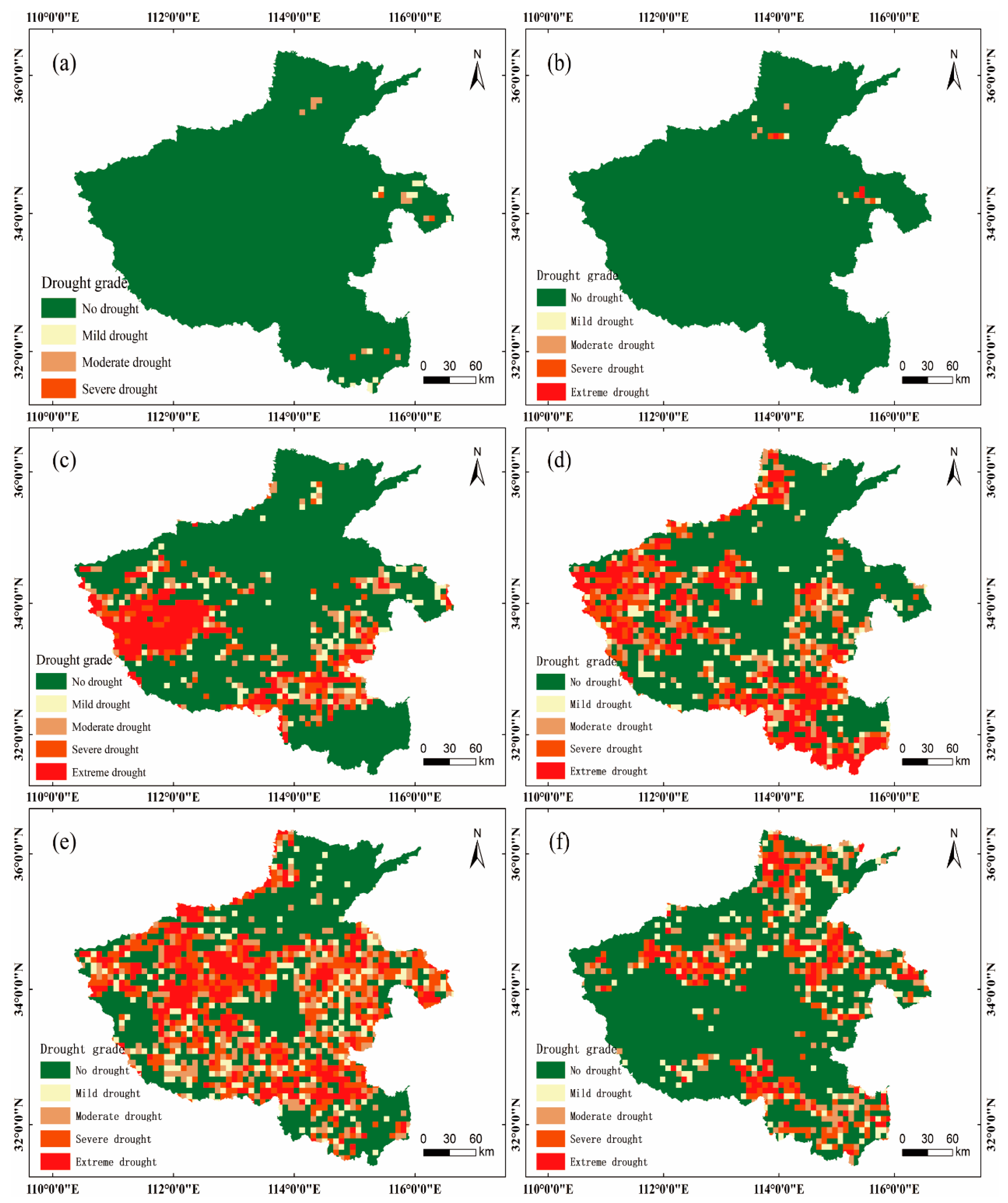

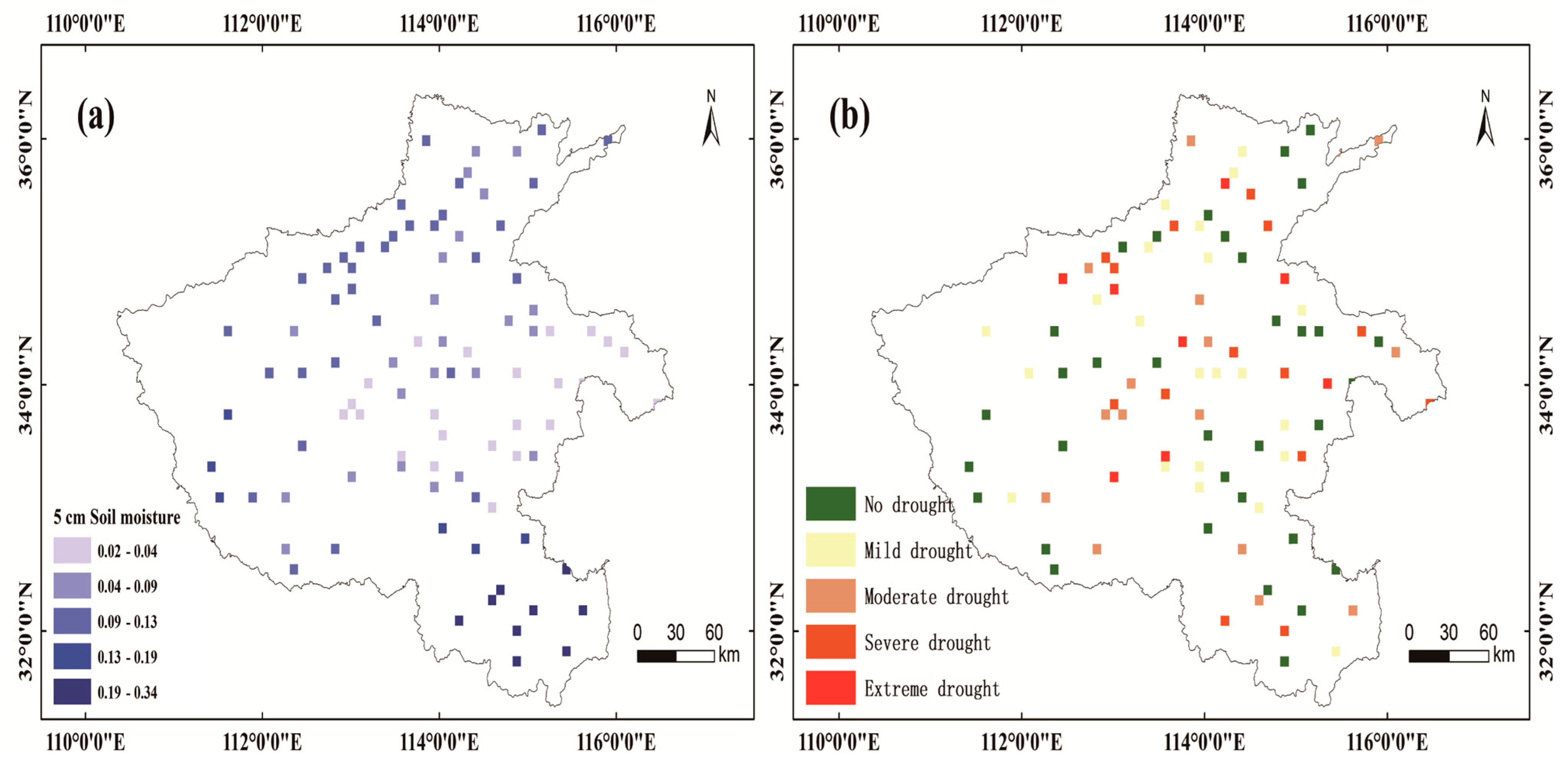
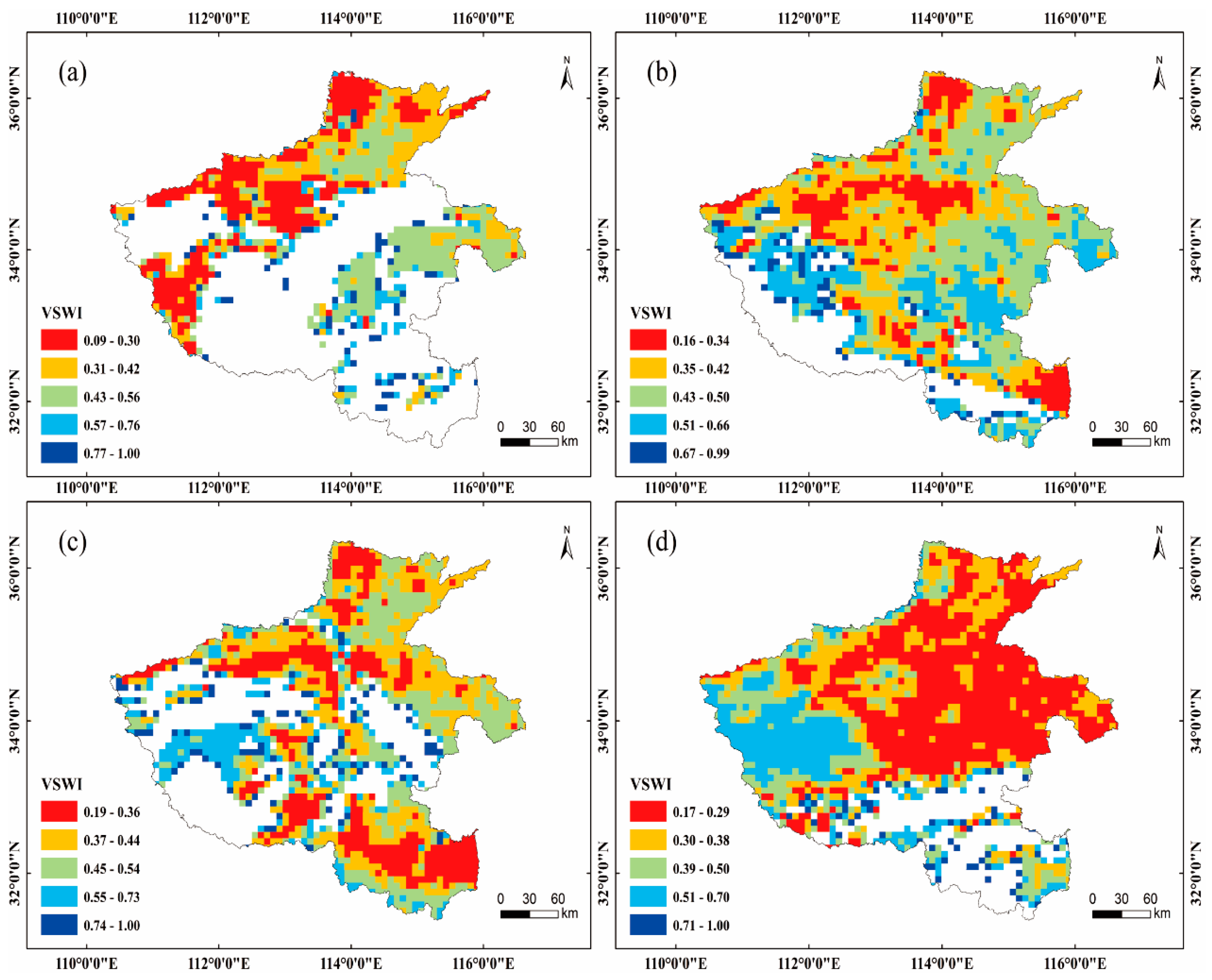
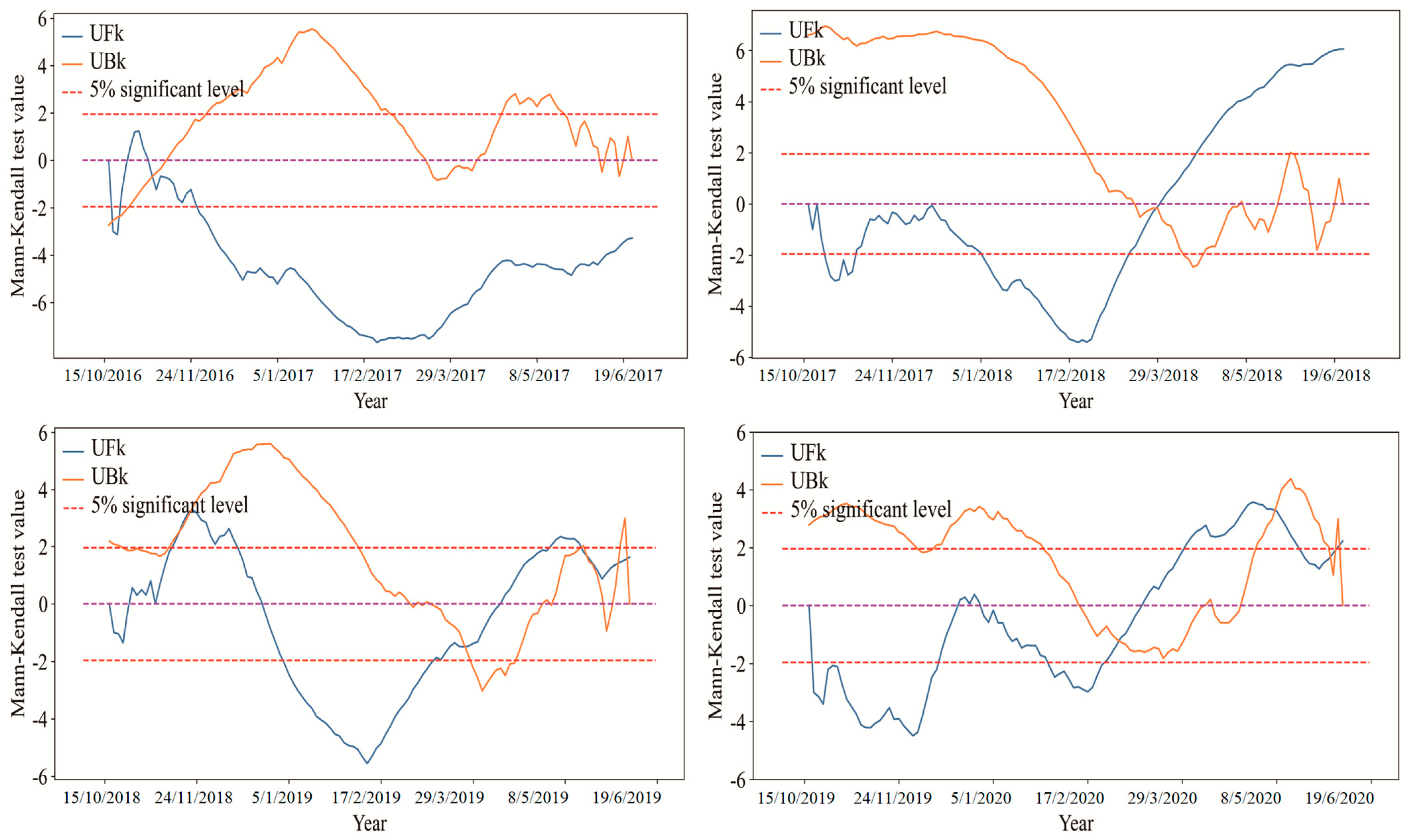

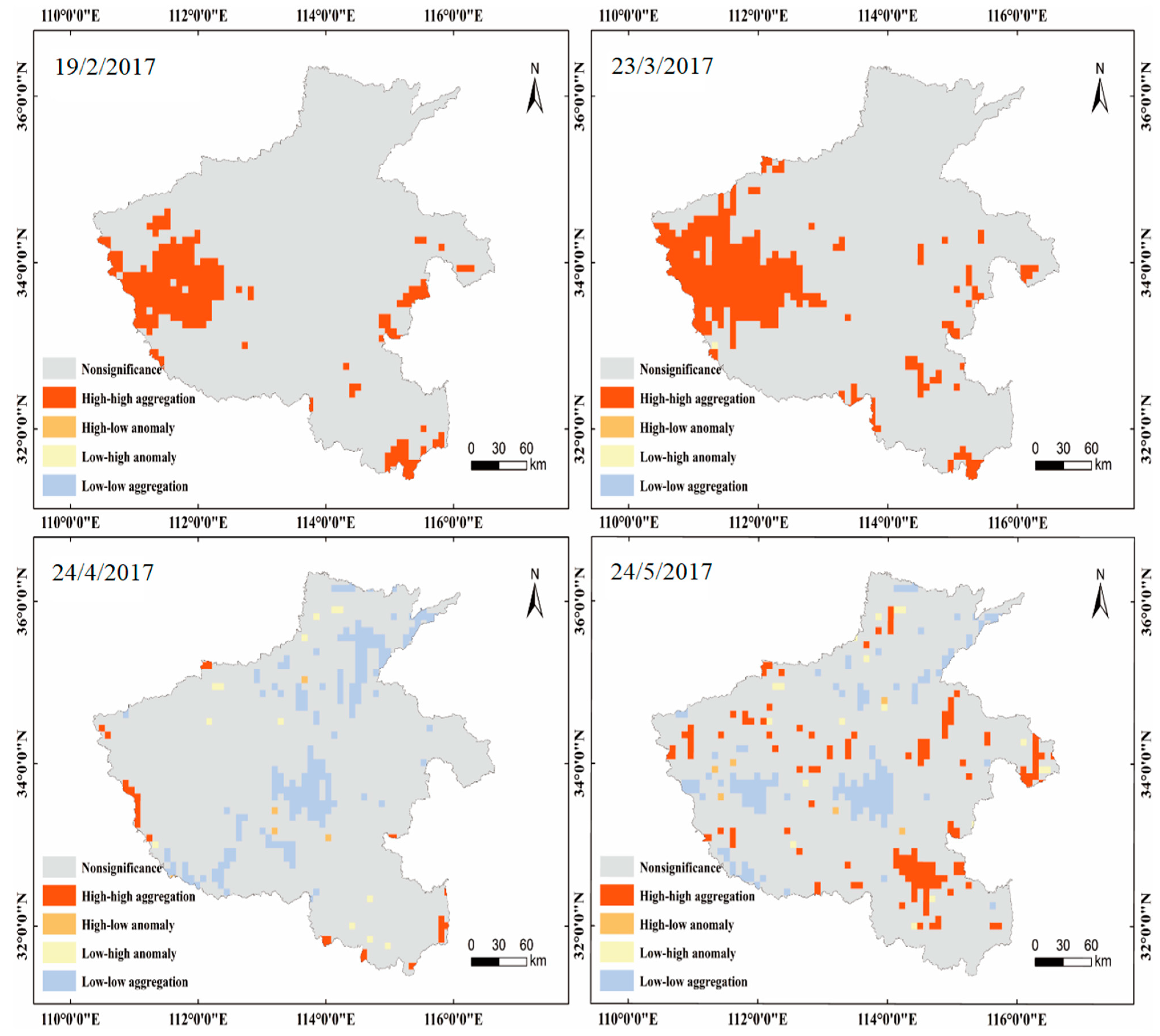
| Data | Unit | Proportional Coefficient | Time Resolution | Spatial Resolution |
|---|---|---|---|---|
| NDVI | 0.0001 | 16 day | 500 m | |
| LST | K | 0.02 | 8 day | 1000 m |
| ET | kg/m2/8 day | 0.1 | 8 day | 500 m |
| Region | Area (10,000 km2) | 2017 (100 Million m3) | 2018 (100 Million m3) | 2019 (100 Million m3) | 2020 (100 Million m3) |
|---|---|---|---|---|---|
| Sanmenxia | 1.03 | 1.44 | 1.36 | 1.13 | 1.83 |
| Xinyang | 1.89 | 10.05 | 10.19 | 10.92 | 10.95 |
| Nanyang | 2.66 | 13.15 | 13.36 | 13.47 | 16.53 |
| Zhoukou | 1.20 | 11.34 | 11.53 | 12.04 | 13.02 |
| Shangqiu | 1.07 | 9.16 | 8.87 | 8.97 | 8.46 |
| Anyang | 0.56 | 8.79 | 9.50 | 8.98 | 9.43 |
| Pingdingshan | 0.79 | 3.07 | 2.79 | 2.72 | 2.76 |
| Kaifeng | 0.63 | 9.12 | 9.91 | 8.96 | 8.43 |
| Xinxiang | 0.82 | 14.52 | 12.76 | 14.02 | 13.26 |
| Luoyang | 1.52 | 4.92 | 4.89 | 5.08 | 4.62 |
| Luohe | 0.26 | 1.49 | 2.05 | 1.53 | 2.67 |
| Puyang | 0.42 | 9.84 | 8.16 | 9.30 | 8.32 |
| Jiaozuo | 0.41 | 8.59 | 8.11 | 8.10 | 6.89 |
| Xuchang | 0.50 | 3.56 | 3.12 | 2.88 | 3.73 |
| Zhengzhou | 0.74 | 5.44 | 4.23 | 4.24 | 3.68 |
| Zhumadian | 1.51 | 4.59 | 5.28 | 5.47 | 5.13 |
| Hebi | 0.23 | 2.81 | 2.69 | 2.80 | 2.56 |
| Time | Sown Area (Thousand Hectares) | Production (Tons) | Wheat Planting Area Proportion (%) |
|---|---|---|---|
| 2017 | 5714.64 | 3705.21 | 54.23 |
| 2018 | 5739.85 | 3602.85 | 52.38 |
| 2019 | 5706.65 | 3741.77 | 53.21 |
| 2020 | 5673.67 | 3753.13 | 54.42 |
| Depth (cm) | Percentage of Water Amount in Different Depths (%) |
|---|---|
| 20 | 41.0 |
| 40 | 25.3 |
| 60 | 17.2 |
| 80 | 6.3 |
| 100 | 4.4 |
| 120 | 4.0 |
| Grade | Type | Relative Soil Moisture at Depth of 20 cm |
|---|---|---|
| 1 | No drought | 60% < RSM |
| 2 | Mild drought | 50% < RSM ≤ 60% |
| 3 | Moderate drought | 40% < RSM ≤ 50% |
| 4 | Severe drought | 30% < RSM ≤ 40% |
| 5 | Extreme drought | RSM ≤ 30% |
| Winter Wheat Phenology Period | NDVI Reflects the Change of Water Requirement of Winter Wheat |
|---|---|
| Seeding emergence period | 0.2 < NDVI < 0.3 |
| Tillering period | 0.3 < NDVI < 0.4 |
| Wintering period | 0.3 < NDVI < 0.4 |
| Regreening jointing period | 0.4 < NDVI < 0.5 |
| Heading and filling period | NDVI > 0.5 |
| Precision | Recall | f1-Score | Support | |
|---|---|---|---|---|
| 0 | 1 | 1 | 1 | 349 |
| 1 | 0.82 | 1 | 0.9 | 1512 |
| 2 | 1 | 0.06 | 0.12 | 161 |
| 3 | 0 | 0 | 0 | 82 |
| 4 | 1 | 0.01 | 0.03 | 68 |
| 5 | 0 | 0 | 0 | 29 |
| accuracy | 0.85 | 2201 | ||
| macro avg | 0.64 | 0.35 | 0.34 | 2201 |
| weighted avg | 0.83 | 0.85 | 0.79 | 2201 |
| Precision | Recall | f1-Score | Support | |
|---|---|---|---|---|
| 0 | 1 | 1 | 1 | 45 |
| 1 | 0.85 | 0.99 | 0.91 | 170 |
| 2 | 0 | 0 | 0 | 16 |
| 3 | 0 | 0 | 0 | 5 |
| 4 | 0 | 0 | 0 | 8 |
| 5 | 0 | 0 | 0 | 1 |
| accuracy | 0.87 | 245 | ||
| macro avg | 0.31 | 0.33 | 0.32 | 245 |
| weighted avg | 0.77 | 0.87 | 0.82 | 245 |
| Global Moran’s I Index | Degree of Correlation |
|---|---|
| 0 < GMI < 1 | Positive correlation |
| −1 < GMI < 0 | Negative correlation |
| GMI = 0 | Uncorrelated |
| Grade | Type | Vegetation Supply Water Index |
|---|---|---|
| 1 | No drought | 0.5 < VSWI |
| 2 | Mild drought | 0.4 < VSWI ≤ 0.5 |
| 3 | Moderate drought | 0.3 < VSWI ≤ 0.4 |
| 4 | Severe drought | 0.2 < VSWI ≤ 0.3 |
| 5 | Extreme drought | VSWI ≤ 0.2 |
Disclaimer/Publisher’s Note: The statements, opinions and data contained in all publications are solely those of the individual author(s) and contributor(s) and not of MDPI and/or the editor(s). MDPI and/or the editor(s) disclaim responsibility for any injury to people or property resulting from any ideas, methods, instructions or products referred to in the content. |
© 2024 by the authors. Licensee MDPI, Basel, Switzerland. This article is an open access article distributed under the terms and conditions of the Creative Commons Attribution (CC BY) license (https://creativecommons.org/licenses/by/4.0/).
Share and Cite
Tian, G.; Zhu, L. Drought Monitoring of Winter Wheat in Henan Province, China Based on Multi-Source Remote Sensing Data. Agronomy 2024, 14, 758. https://doi.org/10.3390/agronomy14040758
Tian G, Zhu L. Drought Monitoring of Winter Wheat in Henan Province, China Based on Multi-Source Remote Sensing Data. Agronomy. 2024; 14(4):758. https://doi.org/10.3390/agronomy14040758
Chicago/Turabian StyleTian, Guizhi, and Liming Zhu. 2024. "Drought Monitoring of Winter Wheat in Henan Province, China Based on Multi-Source Remote Sensing Data" Agronomy 14, no. 4: 758. https://doi.org/10.3390/agronomy14040758






